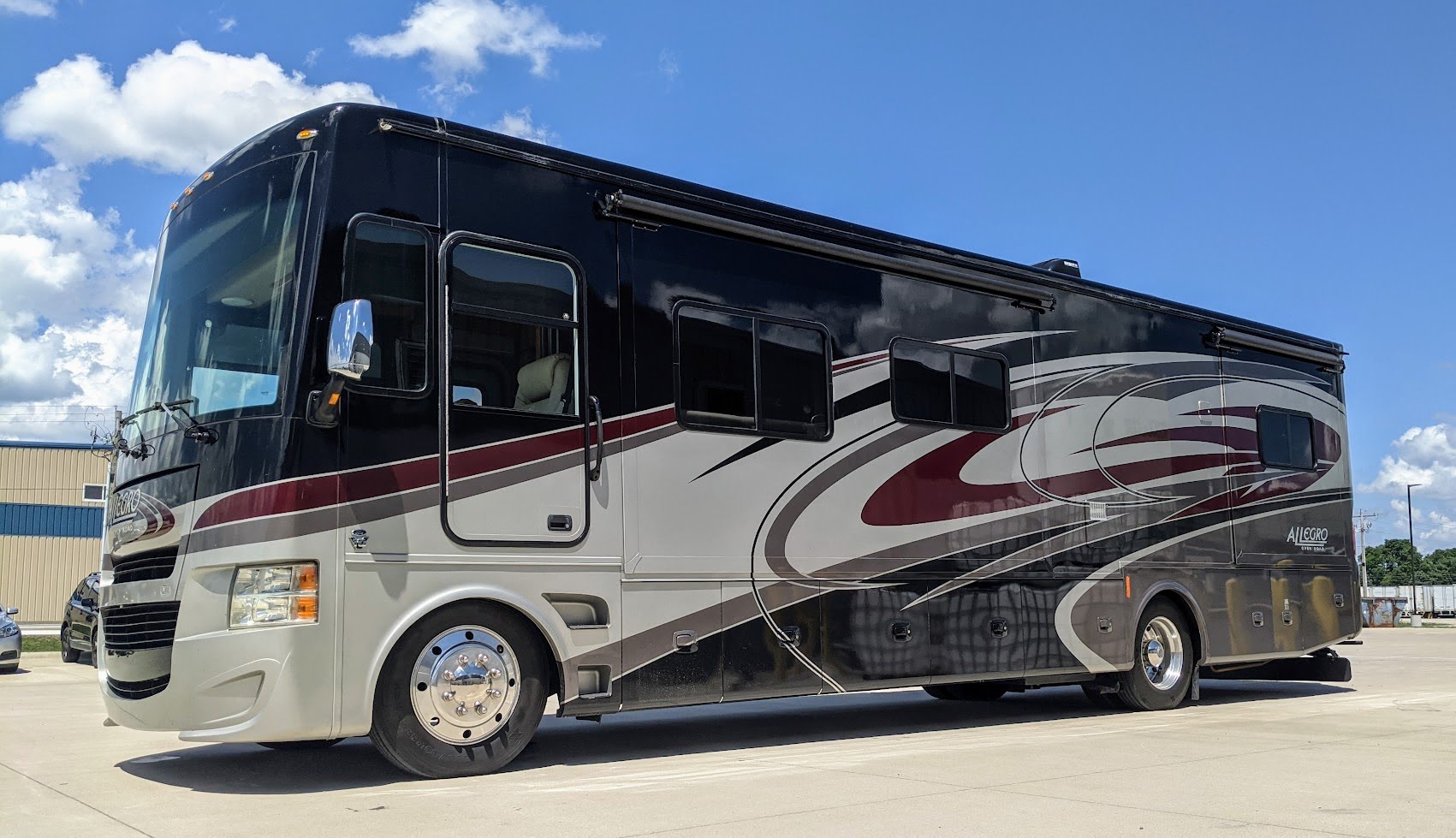Earlier this year, two friends set out with a mission: to compare rides. One friend, Brian, traded his 2016 Tiffin Open Road 35 QBA with a 4-corner LiquidSpring suspension for another friend’s (Bill) 2021 Tiffin Allegro Bus 40IP (without a LiquidSpring suspension). The swap resulted in some impressive final statements, as well as rounds of applause and conversation from the Tiffin Open Roaders group on Facebook.
We’re happy to share their experiences in this two-part series. Below, you will find Brian’s review. From there, feel free to read Bill’s take on the swap.
In Brian’s Words:
A very good friend kindly offered me this opportunity and I wasted no time in taking him up on it: compare my Qubie (2016 35QBA) with 4-corner LiquidSpring to a high-end diesel. Since even before I had our LS system installed, I’ve been building up this comparison in my mind: How would a relatively inexpensive gas coach (with a notable upgrade in an adaptive suspension) compare to a near-top-of-the-line coach on a state of the art diesel pusher chassis?
What better way to compare than a ride?
To that end, my friend graciously allowed me to take his 2021 Tiffin Allegro Bus 40IP for a roughly 30-minute test drive. (Yes, we plan to have him drive the Qubie to do the reverse comparison soon. He came from an Open Road with rear LS so he has a good basis).
We [test drove] country roads, some freeway, bridge joints, and potholes.
How did it feel? I have to admit that I think that Qubie has the edge in handling and comfort. Yes, I said it.
I admit that I always assumed the high-end diesels had “magic carpet rides,” though intellectually, I knew that there was little basis for that belief. As I mentioned in my extensive video review of my LS install, the air ride suspensions on these things are simple, static systems that provide damping based on air. The LS system is an adaptive suspension that reacts one thousand times per second to the state of the road (and the driver). On paper, it honestly should have an edge in handling and comfort over a “dumb” air bag system.
I personally think it does. The biggest difference to me was in the “whoopty doos” from bridge connections. Qubie eats those, unflappably. Perfect control, and nearly unbelievable removal of follow-on motion. There’s no double bounce in Qubie. There’s hardly a bounce to begin with, but there’s definitely no double bounce unless there are more road imperfections. The Allegro Bus felt good going across those, but you definitely feel them and it’s a kind of wallowing, floating effect both when hitting it and with follow-on motion. It doesn’t flap about ridiculously but there’s definitely a bit of rebound.
The rest of the handling and comfort are quite similar to me. Potholes and quick dynamics are the enemy of all suspension systems. We hit one pothole that had the entire coach resonating. I feel like Qubie protects us a bit more than the Allegro Bus did but I hope to hit that same hole soon and see for sure. That’s my memory anyway.
Now. Is Qubie better in every way? Of course not.
The cabin is super quiet in the Allegro Bus. Of course; it’s a rear-engine diesel. The steering is definitely tighter in the Bus, with fewer — but not none! — steering corrections required (note: I have a Safe-T-Steer installed on Qubie). The brakes are absolute monsters in the Allegro Bus. I felt like I could peel up pavement if I stomped on those things. The Bus has the irreplaceable advantage of mass which no amount of fancy suspension shenanigans are ever going to beat. Wind gusts and passing trucks will always effect our little, light Open Roads more than the big boys. The power was a wash to me. It didn’t feel any peppier getting going, but it certainly moved with much less apparent drama given the relative silence of the cabin.
I’ll withhold final judgment until my friend has a chance to weigh in on Qubie’s drivability, but to me it solidified our decision to have LiquidSpring installed. My wife, who unfortunately couldn’t join us today, asked me when I got home whether I now wanted a Bus or a Phaeton and I was comfortable in saying “actually, I love Qubie even more!” No offense to my Allegro Bus-owning friend, of course, but that’s a very nice takeaway: “No, I don’t want to spend another $200k to $300k — or more! — to upgrade to this other thing.”
I often see the sentiment in this group that LiquidSpring suspension systems are too expensive and that you should just take that money and invest it in a diesel. Especially if you have an older Open Road. I will disagree. If you are someone who loves your Open Road but are dissatisfied with the handling and comfort of your coach and you intend to use your coach for the foreseeable future I think it makes a lot of sense, even if it’s an older coach. If the resale value is the most important consideration or you’re selling it in 6 months, then no, it doesn’t make a ton of sense.
The “just get a diesel” argument specifically for handling and comfort in comparison also doesn’t hold a lot of water to me. The relative investment to upgrade from Qubie to a diesel that even comes close to meeting a LS-enhanced chassis has to be at least $100k, and that’s moving to a similar-aged coach. I could go older but now I’m inheriting an aging platform in more ways than one. That doesn’t count the increased annual maintenance costs, increased potential tax impact, or other associated costs. Compared to ~$20k for LS I feel like I got a bargain! Especially if I think Qubie actually rides better!
Now, obviously everyone has to do that math for themselves and their situation. I certainly won’t tell anyone how to or how not to spend their money. But, I’m very pleased with how Qubie fared in comparison to a truly beautiful, top-of-the-line coach and figured it would be another useful data point for people, especially those who haven’t been able to ride in a diesel or in a LS-equipped coach.
To read Bill’s review of the swap, follow this link.

